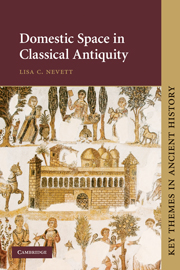Book contents
- Frontmatter
- Contents
- List of figures
- List of plates
- Preface and acknowledgements
- Map showing the locations of the sites and regions discussed in Chapters 3–6
- Introduction
- 1 Domestic space and social organisation
- 2 House-form and social complexity: the transformation of Early Iron Age Greece
- 3 A space for ‘hurling the furniture’? Architecture and the development of Greek domestic symposia
- 4 Housing and cultural identity: Delos, between Greece and Rome
- 5 Seeking the domus behind the dominus in Roman Pompeii: artefact distributions as evidence for the various social groups
- 6 Housing as symbol: elite self-presentation in North Africa under Roman rule
- Epilogue: domestic space and social organisation in Classical Antiquity
- Glossary
- Period names and dates referred to in this book
- Bibliographic essay
- Bibliography
- Index
2 - House-form and social complexity: the transformation of Early Iron Age Greece
Published online by Cambridge University Press: 05 August 2012
- Frontmatter
- Contents
- List of figures
- List of plates
- Preface and acknowledgements
- Map showing the locations of the sites and regions discussed in Chapters 3–6
- Introduction
- 1 Domestic space and social organisation
- 2 House-form and social complexity: the transformation of Early Iron Age Greece
- 3 A space for ‘hurling the furniture’? Architecture and the development of Greek domestic symposia
- 4 Housing and cultural identity: Delos, between Greece and Rome
- 5 Seeking the domus behind the dominus in Roman Pompeii: artefact distributions as evidence for the various social groups
- 6 Housing as symbol: elite self-presentation in North Africa under Roman rule
- Epilogue: domestic space and social organisation in Classical Antiquity
- Glossary
- Period names and dates referred to in this book
- Bibliographic essay
- Bibliography
- Index
Summary
Bronze walls led in all directions from the doorway to the inside and the cornice around them was blue; gold doors opened into the carefully built house; silver doorposts stood over the bronze threshold, with a silver lintel above and a gold handle; on each side there were gold and silver dogs…Inside there were seats all along the walls from the doorway to the interior and on them were fine, well-made fabrics, women's handiwork…And gold boys stood on well-made bases holding bright torches in their hands, shining at night for diners in the house.
Homer, Odyssey 7.86–97The organization of the built environment and use of space is a metaphor for the organization of a culture; the former are the visible, tangible expressions of invisible, intangible culture. The amount of segmentation present in a culture structures its architecture and spatial patterns…
Kent 1991, 31INTRODUCTION: ISSUES AND APPROACHES
Homeric descriptions like that of the extensive and opulent palace of King Alcinoös in the Odyssey, quoted above represent our earliest surviving descriptions of housing from the ancient Greek world. Nineteenth- and early twentieth-century archaeologists were tempted to associate these poetically imagined structures with the monumental palatial buildings being unearthed at the time at sites such as Tiryns and Mycenae. But it became clear that whereas the palaces were probably destroyed before 1200 bce, the Homeric poems did not come together in their final form until about the eighth century bce.
- Type
- Chapter
- Information
- Domestic Space in Classical Antiquity , pp. 22 - 42Publisher: Cambridge University PressPrint publication year: 2010



